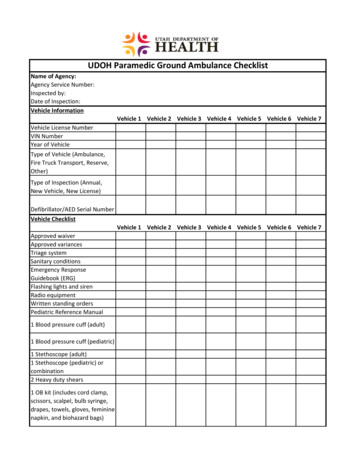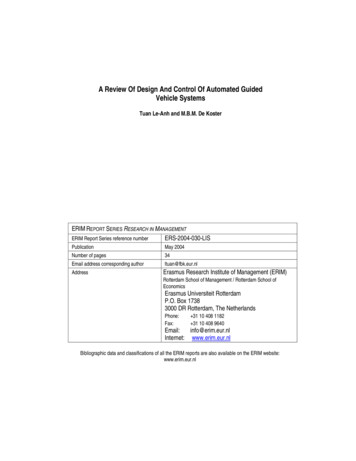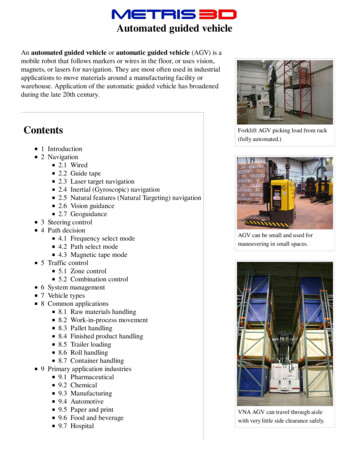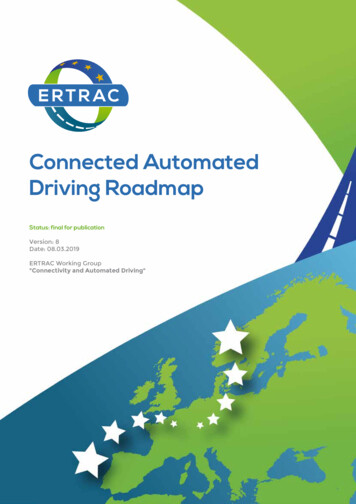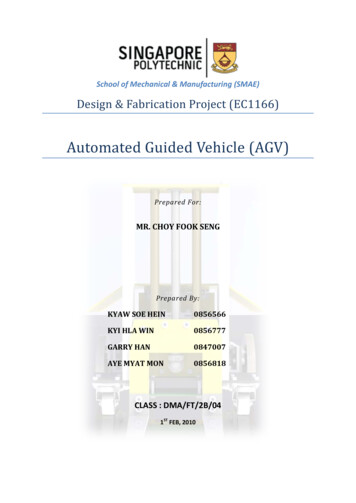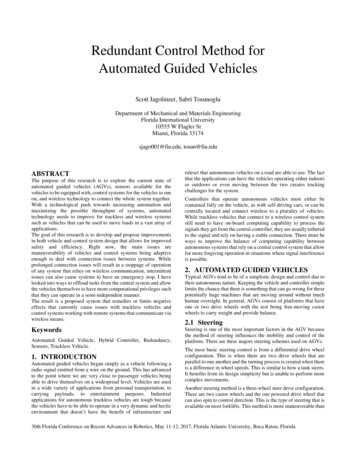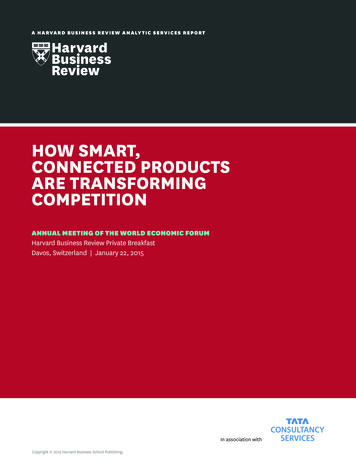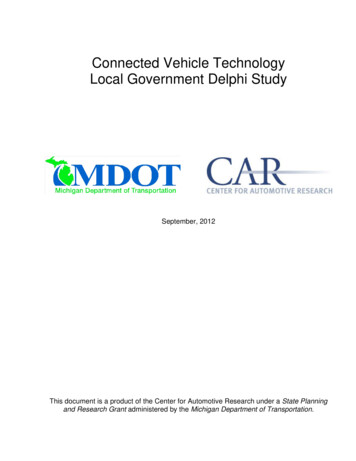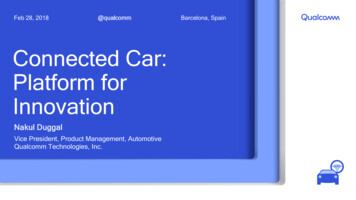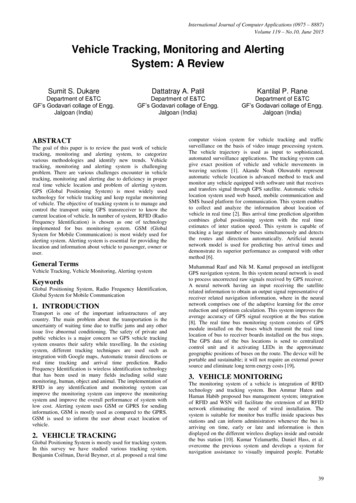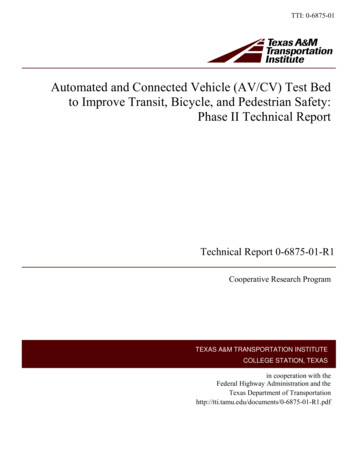
Transcription
TTI: 0-6875-01Automated and Connected Vehicle (AV/CV) Test Bedto Improve Transit, Bicycle, and Pedestrian Safety:Phase II Technical ReportTechnical Report 0-6875-01-R1Cooperative Research ProgramTEXAS A&M TRANSPORTATION INSTITUTECOLLEGE STATION, TEXASin cooperation with theFederal Highway Administration and theTexas Department of -01-R1.pdf
1. Report No.2. Government Accession No.Technical Report Documentation Page3. Recipient's Catalog No.FHWA/TX-18/0-6875-01-R14. Title and Subtitle5. Report DateAUTOMATED AND CONNECTED VEHICLE (AV/CV) TEST BEDTO IMPROVE TRANSIT, BICYCLE, AND PEDESTRIAN SAFETY:PHASE II TECHNICAL REPORTPublished: October 20206. Performing Organization Code7. Author(s)8. Performing Organization Report No.Katherine F. Turnbull, Kevin Balke, Srinivasa Sunkari, HassanCharara, Chris Bratlien, Shuman Tan, Laura Higgins, Kay Fitzpatrick,and Linda CherringtonReport 0-6875-01-R19. Performing Organization Name and Address10. Work Unit No. (TRAIS)Texas A&M Transportation InstituteThe Texas A&M University SystemCollege Station, Texas 77843-313511. Contract or Grant No.12. Sponsoring Agency Name and Address13. Type of Report and Period CoveredTexas Department of TransportationResearch and Technology Implementation Office125 E. 11th StreetAustin, Texas 78701-2483Technical Report:April 2016–December 2018Project 0-6875-0114. Sponsoring Agency Code15. Supplementary NotesProject performed in cooperation with the Texas Department of Transportation and the Federal HighwayAdministration.Project Title: Automated and Connected Vehicle (AV/CV) Test Bed to Improve Transit, Bicycle, andPedestrian Safety—Phase IIURL: http://tti.tamu.edu/documents/0-6875-01-R1.pdf16. AbstractCrashes involving transit vehicles, bicyclists, and pedestrians are a concern in Texas, especially in urbanareas. This research explored the potential of automated and connected vehicle (AV/CV) technology toreduce or eliminate these crashes. The project objectives focused on identifying safety concerns related to theinteraction of transit vehicles, bicyclists, and pedestrians, and targeting AV/CV technologies to mitigate oreliminate those concerns. In Phase II, concept applications were identified, along with public- and privatesector partners. A concept of operations (ConOps) Plan for designing, testing, piloting, demonstrating, anddeploying candidate applications through an AV/CV test bed to improve transit, bicycle, and pedestriansafety was developed.Phase II focused on improving safety at signalized intersections, which represents complex space for buses,bicyclists, and pedestrians. Research activities included identifying use cases and alert scenarios for busesand pedestrians interacting at intersections, developing the system requirements, and developing the testplan, test scenarios, and test procedures for the proof-of-concept tests. Researchers conducted a preliminarytest of possible alert methods and messages. A proof-of-concept test was conducted at a new state-of-the-artsmart intersection at The Texas A&M University System’s RELLIS Campus.17. Key Words18. Distribution StatementAutonomous Vehicles, Automated Vehicles,Connected Vehicles, Public Transit, Buses, Bicycles,Pedestrians, Smart IntersectionsNo restrictions. This document is available to thepublic through NTIS:National Technical Information ServiceAlexandria, Virginiahttp://www.ntis.gov19. Security Classif. (of this report)20. Security Classif. (of this page)21. No. of PagesUnclassifiedUnclassified138Form DOT F 1700.7 (8-72) Reproduction of completed page authorized22. Price
AUTOMATED AND CONNECTED VEHICLE (AV/CV) TEST BED TOIMPROVE TRANSIT, BICYCLE, AND PEDESTRIAN SAFETY: PHASE IITECHNICAL REPORTbyKatherine F. TurnbullExecutive Associate DirectorShuman TanAssociate Transportation ResearcherKevin BalkeResearch EngineerLaura HigginsAssociate Research ScientistSrinivasa SunkariResearch EngineerKay FitzpatrickSenior Research EngineerHassan ChararaSoftware Applications Developer IVLinda CherringtonResearch ScientistChris BratlienSoftware Applications Developer IIITexas A&M Transportation InstituteReport 0-6875-01-R1Project 0-6875-01Project Title: Automated and Connected Vehicle (AV/CV) Test Bed to Improve Transit, Bicycle,and Pedestrian Safety—Phase IIPerformed in cooperation with theTexas Department of Transportationand the Federal Highway AdministrationPublished: October 2020TEXAS A&M TRANSPORTATION INSTITUTECollege Station, Texas 77843-3135
DISCLAIMERThis research was performed in cooperation with the Texas Department of Transportation(TxDOT) and the Federal Highway Administration (FHWA). The contents of this report reflectthe views of the authors, who are responsible for the facts and the accuracy of the data presentedherein. The contents do not necessarily reflect the official view or policies of the FHWA orTxDOT. This report does not constitute a standard, specification, or regulation.The United States Government and the State of Texas do not endorse products or manufacturers.Trade or manufacturers’ names appear herein solely because they are considered essential to theobject this report.v
ACKNOWLEDGMENTSThis project was conducted in cooperation with TxDOT and FHWA. Wade Odell of TxDOTserved as the project manager. Darla Walton and Teri Kaplan, TxDOT, served on the projectteam. Rachael Sears and Chris Pourteau, TTI, provided word processing and editing review onthis document, respectively. The assistance and contributions of all these individuals isacknowledged and greatly appreciated.vi
TABLE OF CONTENTSList of Figures . xList of Tables . xiiI.Introduction . 1Background, Project Objectives, and Activities. 1Organization of Report . 2II.Review of Transit, Bicycle, and Pedestrian AV/CV Technology Demonstrations andResearch . 3Bus-Based Collision-Warning Systems . 3Summary of Mobileye Pilots. 3Florida Advanced Driver Assistance Systems Pilot . 4New York City Transit Pilot. 5Washington State Demonstration Pilot . 5Pierce Transit Pilot . 6Virginia Department of Rail and Public Transportation Pilot . 6Miami-Dade Department of Transportation and Public Works Pilot . 6Dallas Area Rapid Transit (DART) . 7Protran Safe Turn Alert 2.0 . 7Greater Cleveland Regional Transit Authority and Battelle-Enhanced Transit Safety RetrofitPackage. 7Low-Speed Autonomous Shuttles . 8Minnesota Department of Transportation (MnDOT) Autonomous Bus Pilot Program . 8Driverless Shuttles Arlington Entertainment District. 10Hop On Driverless Shuttle, Las Vegas . 11Autonomous Shuttles, Bishop Ranch, San Ramon . 12Mcity Driverless Shuttle Research Project, University of Michigan North Campus . 12Autonomous Shuttles, Texas A&M University Campus and Downtown Bryan . 13European Driverless Transit Shuttles . 16Smartphone Apps for Pedestrians and Bicyclists . 17TravelSafely app, Atlanta North Avenue Smart Corridor . 17Wayfinding App for Transit Riders with Visual Impairments, Houston METRO . 18Federal Highway Administration — Pedestrian Mid-Block Crossing Application . 19Current Research Projects . 20University of Nevada, Reno and Proterra Partner on Autonomous Public TransitResearch . 20Bluetooth Pedestrian Awareness System (BPAS) . 20U.S. Department of Transportation (USDOT) and European Commission (EC)Research Projects Using Simulation to Examine the Behavior and Interaction ofDrivers, Pedestrians, and Bicyclists . 21University of Minnesota — Smart Human Centered Collision Warning System:Sensors, Intelligent Algorithms and Human-Computer Interfaces for Safe andMinimally Intrusive Car-Bicycle Interactions . 22III.Use Cases and Alert Scenarios . 23Use Case 1A: Right-Turning Connected Bus with a Pedestrian in the Pedestrian DetectionZone . 25Use Case 1B: Right-Turning Bus with No Pedestrian in the Pedestrian Detection Zone . 27vii
Use Case 2A: Left-Turning Bus with a Pedestrian Located in the Opposite Corner of thePedestrian Detection Zone. 28Use Case 3A: Through Bus with a Pedestrian Located in the Pedestrian Detection Zone. . 29Use Case 3B: Through Bus with Two Pedestrian Detection Zones. . 30Use Case 4A: Turning Bus Stopping at a Nearside Bus Stop . 31Use Case 4B: Turning Bus Stopping at a Nearside Bus Stop with Two Pedestrian DetectionZones . 32Use Case 5A: Two Buses Approaching the Intersection in Same Direction . 33Use Case 5B: Multiple Buses Approaching the Intersection Simultaneously from DifferentDirections . 35Use Case 6A: Bus Vehicle ID Not Matched to Route . 35Use Case 6B: Incorrect Bus Route in the Transit Management Center . 35Use Case 6C: Temporary or Long-Term Detours . 35IV.System Requirements. 37System Description . 37System Configuration . 38System Detection. 39System Alerts . 40Bus Route . 42System Connected Bus Information . 42System Data Logging . 43V.Input on Potential Warning Technologies, Methods, and Messages . 45Preliminary Pilot Test of Pedestrian Alert Methods . 45Methodology. 45Conducting the Preliminary Pilot Test . 48Summary of Walking Course Information . 49Post-Walk Survey Analysis . 51Pedestrian Intercept Surveys and Focus Group . 55Pedestrian Intercept Surveys . 55Focus Groups . 60Conclusions from Pedestrian Surveys and Focus Groups . 65VI.Test Plan, Test Scenarios, Test Procedures, and Proof-of-Concept Test. 67Test Plan . 67Test Scenarios, Procedures, and Proof-of-Concept Test . 73VII. Roundtable Forum . 97Overview . 97Agenda and Participants . 97Project Update . 99Proof-of-Concept Demonstration . 101Possible Phase III Projects and Wrap-Up Discussion . 104VIII. Potential Phase III Deployment Projects . 107University Drive and Asbury Street, College Station . 107Gessner Road and Long Point Road, Houston . 108North LBJ Drive (Loop 82) and East Hutchinson Street, San Marcos . 109Appendix A: Post-Walk Survey. 111Appendix B: “Bus Crossing” Pedestrian Warning — Intercept Survey . 115viii
Appendix C: “Bus Crossing” Pedestrian Warning — Focus Group Guide . 117Appendix D: “Bus Crossing” Pedestrian Warning — Spanish Focus Group Guide . 119Bibliography . 123ix
LIST OF FIGURESFigure 1. Rosco Mobileye Shield Display on Texas A&M University Bus. . 4Figure 2. Milo Driverless Shuttle — Arlington Entertainment District. . 11Figure 3. The Mcity Driverless Shuttle. 13Figure 4. The NAVYA Shuttle on the Texas A&M Campus. . 14Figure 5. Self-Driving Trolley Piloted in Downtown Bryan. . 16Figure 6. Bluetooth Device on METRO Bus Stop Sign. . 19Figure 7. Test of App with Visually Impaired Bus Riders. . 19Figure 8. Smart Four-Way Intersection. . 23Figure 9. Use Case 1A: Right-Turning Bus with a Pedestrian in the Pedestrian DetectionZone. . 26Figure 10. Use Case 1B: Right-Turning Bus with No Pedestrian in the Waiting Area orConflict Zone. . 27Figure 11. Use Case 2A: Left-Turning Bus with a Pedestrian Located in the PedestrianDetection Zone on the Opposite Corner. . 28Figure 12. Use Case 3A: Through Bus with a Pedestrian Located in the Pedestrian DetectionZone. . 29Figure 13. Use Case 3B: Through Bus with Two Pedestrian Detection Zones. . 30Figure 14. Use Case 4A: Turning Bus Stopping at a Nearside Bus Stop before Initiating Turn. 31Figure 15. Use Case 4B: Turning Bus Stopping at a Nearside Stop with Two PedestrianDetection Zones. . 32Figure 16. Use Case 5A: Two Buses Approaching the Intersection in the Same Direction. 34Figure 17. Preliminary Pilot Test Course and Location of Pedestrian Alert Devices. . 46Figure 18. Projected Warning Sign. . 46Figure 19. Audible Warning Message Set-Up. . 47Figure 20. Supplemental Bus Warning Sign. 48Figure 21. Test Subjects Preference for Warning Messages. . 52Figure 22. Intersection Locations with METRO Bus Routes. . 56Figure 23. TTI Researcher Conducting a Pedestrian Intercept Survey. . 57Figure 24. Survey Participants’ First and Second Choices for Warning Format. 59Figure 25. Focus Groups Conducted on July 10, 2018. . 61Figure 26. TTI Smart Intersection at RELLIS Campus. . 67Figure 27. GRIDSMART Vision-Based Tracking Feature. . 68Figure 28. POLARA APS System. . 69Figure 29. Supplemental Bus Design. 70Figure 30. Location of Bus Signal at Smart Intersection. . 71Figure 31. Example of Android App Notification. . 72Figure 32. Electronic Invitation and Agenda. . 98Figure 33. Right Turning Bus Use Case — Before Situation. . 102Figure 34. Right Turning Bus Use Case — Bus Approaching the Intersection. . 102Figure 35. Right Turning Bus Use Case — Bus Turning through the Intersection. . 103Figure 36. Right Turning Bus Use Case — Bus Clears the Intersection. . 103Figure 37. Roundtable Forum Participants at the Smart Intersection Proof-of-Concept Test. . 104Figure 38. University Drive and Asbury Street, College Station. . 108x
Figure 39. Gesner Road and Long Point Road, Houston. . 109Figure 40. North LBJ Drive and East Hutchinson Street, San Marcos. . 110xi
LIST OF TABLESTable 1. Smart Intersection Uses Cases. . 24Table 2. Requirement Category: System Description. 37Table 3. Requirement Category: Configuration. 38Table 4. Requirement Category: Detection. . 39Table 5. Requirement Category: Alerts. . 41Table 6. Requirement Category: Bus Route. . 42Table 7. Requirement Category: Connected Bus Information. 43Table 8. Requirement Category: Data Logging. . 43Table 9. Gender and Age Distribution of Test Subjects. . 48Table 10. Remembered Message Displayed on Alert Devices. . 51Table 11. Effectiveness of Alert Device in Capturing the Attention of a Pedestrian. . 53Table 12. Effectiveness of Devices Conveying the Alert Message. . 54Table 13. Average Scores of Alert Devices. . 55Table 14. Survey Participant Characteristics. . 58Table 15. Test Scenario and Procedures for Use Case 1A. . 74Table 16. Test Scenario and Procedures for Use Case 1B. . 76Table 17. Test Scenario and Procedures for Use Case 2A. . 78Table 18. Test Scenario and Procedures for Use Case 3A. . 80Table 19. Test Scenarios and Procedures for Use Case 4A. . 82Table 20. Test Scenarios and Procedures for Use Case 5A. . 85Table 21. Test Scenarios and Procedures for Use Cases 6A, 6B, and 6C. . 88Table 22. Test Scenario and Procedures for the Audible Alert Device. . 90Table 23. Scenario and Procedures for the Supplemental Bus Warning Sign. . 92Table 24. Test Scenario and Procedures for the Smartphone app. . 94Table 25. Participants in the October 23, 2018, Roundtable Forum. 99xii
I.INTRODUCTIONBACKGROUND, PROJECT OBJECTIVES, AND ACTIVITIESPublic transit vehicles, bicyclists, and pedestrians share roads in urban, suburban, and rural areas.Crashes involving transit vehicles, bicyclists, and pedestrians are a concern in Texas, especiallyin urban areas. The 2013 National Transit Database reported 657 incidents, 836 injuries, and 6fatalities involving transit vehicles, bicyclists, and pedestrians in Texas. In addition to injuriesand the tragic loss of life, these incidents have financial consequences. A 2017 pedestrian fatalityin Seattle involving a bus making a right turn at an intersection resulted in a 7.7 millionsettlement.This research explored the potential of automated and connected vehicle (AV/CV) technology toreduce or eliminate these crashes. The project objectives focused on identifying safety concernsrelated to the interaction of transit vehicles, bicyclists, and pedestrians, and targeting AV/CVtechnologies to mitigate or eliminate those concerns. In Phase I, concept applications wereidentified, along with possible public- and private-sector partners. A concept of operations(ConOps) plan for designing, testing, piloting, demonstrating, and deploying candidateapplications through an AV/CV test bed to improve transit, bicycle, and pedestrian safety wasdeveloped. It included the overall vision and goals for the test bed and described the operationalscenarios — the who, what, why, where, when, and how — for the near-term candidateapplications. The applications focus on smart buses, smart intersections, smart bicycles andpedestrians, and smart bike racks on buses.In Phase I, the research team conducted 25 meetings and 4 workshops with diverse stakeholdergroups to gain insight into safety issues and concerns, as well as ideas on possible technologiesto address these problems. The research team also reviewed AV/CV case studies of relatedtechnologies and examined federal, state, and local legislation and policies related to AV/CV,bicyclist, and pedestrians. A pilot of a camera and sensor-based collision-avoidance system wasconducted on one Texas A&M University bus. The pilot was monitored, and the results wereused to assist in developing the ConOps plan. Roundtable forums were held with stakeholdersand technology firms to review the near-term applications and to identify possible partnerships.The Phase I activities were documented in the 2016 Automated and Connected Vehicle (AV/CV)Test Bed to Improve Transit, Bicycle, and Pedestrian Safety: Technical Report. The activitiesconducted in Phase II — focusing on enhancing safety at signalized intersections, whichrepresent complex shared space for buses, bicyclists, and pedestrians — are summarized in thisreport.The smart intersection and the smartphone app included in the Phase I ConOps plan weredeveloped and piloted in Phase II. Researchers first identified the use cases and alert scenariosfor the smart intersection. The use cases include the location and action of bases and pedestriansfor the different scenarios focusing on right turning, left turning, and through buses. Researchersnext developed the system requirements, including the system configuration, system detection,system alerts, bus-route information, connected-bus information, and data-logging information.1
Researchers conducted a preliminary test on the Texas A&M University campus of possiblepedestrian alert methods and surveyed pedestrians at three intersections in Houston to obtainadditional information on preferred alert messages and methods. Researchers also conductedthree focus groups in Houston with individuals using wheelchairs, individuals with visualimpairments, and individuals with hearing loss to gain further insights into alert methods andmessages for disabled pedestrians.Researchers developed the test plan, test scenarios, and test procedures for the use cases. Anaudio alert message (“caution bus turning” in English and Spanish) and a visual method (asupplemental bus sign above the pedestrian signal) were used in the pilot. A beta androidsmartphone app was also developed and tested.TTI installed a state-of-the-art smart intersection at The Texas A&M University System’sRELLIS Campus to pilot test the system. The smart intersection was developed through a publicprivate partnership. TTI resources covered construction of the intersection and some equipment.Econolite donated most of the traffic signal control and detection equipment, including twosignal cabinets. This TxDOT project provided the first use of the smart intersection, with proofof-concept tests conducted on seven of the use cases and the audible warning, the supplementalbus sign, and the beta smartphone app.The project concluded with a roundtable forum on October 23, 2018. Representatives fromTxDOT, transit agencies, Metropolitan Planning Organizations (MPOs), and other groupsparticipated in the roundtable forum. The roundtable forum included a project update and aproof-of-concept demonstration of the smart intersection and smartphone app at the RELLISCampus. Participants discussed and voiced support for moving forward with possible Phase IIIdeployment projects.ORGANIZATION OF REPORTThis report is organized into eight sections. Following this introduction in Sect
test of possible alert methods and messages. A proof-of-concept test was conducted at a new state-of-the-art smart intersection at The Texas A&M University System's RELLIS Campus. 17. Key Words Autonomous Vehicles, Automated Vehicles, Connected Vehicles, Public Transit, Buses, Bicycles, Pedestrians, Smart Intersections 18. Distribution Statement
